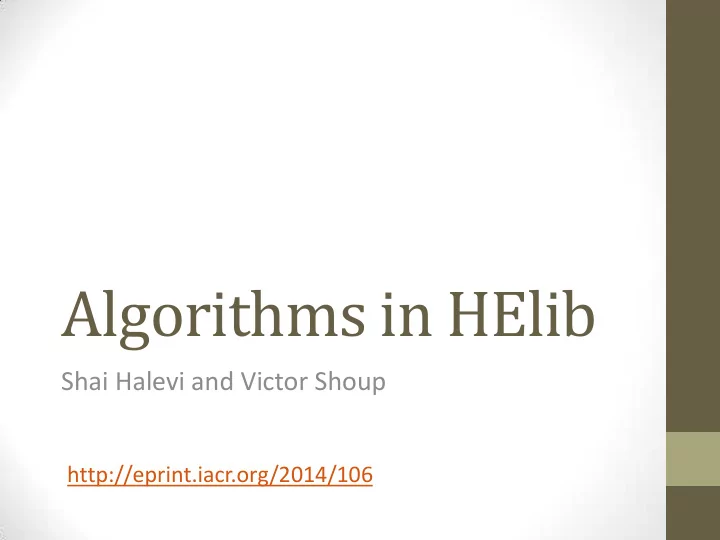

Algorithms in HElib Shai Halevi and Victor Shoup http://eprint.iacr.org/2014/106
What’s HElib? • A software library implementation of homomorphic encryption (HE) • Implements the ring-LWE variant of [BGV12] • Written in C++, uses NTL for poly-arithmetic • Open source (GPL), available off https://github.com/shaih/HElib/ • Focused on effective use of “ ciphertext packing” [SV11] and the routing techniques from [GHS12]
What’s Implemented in HElib? Low level: the cryptosystem itself • Useful analogy: “assembly language” for homomorphic computations • The HE schemes serves as a “hardware platform” • Defining the available operations and their cost Higher level: algorithms over this “platform” • Routing algorithms • Simple linear functions
The HE “platform” • Each ciphertext encrypts a vector 𝑤 ∈ 𝐺 𝑜 • 𝐺 can be “any finite field” of our choice • 𝑜 is determined by the system parameters • Typical values are 𝑜 ∈ [100, 1000] • Operations are rotations, element-wise addition & multiplication • This is a SIMD environment • Not very different from Intel SSE etc.
The HE “platform” • Cost measured in time, noise • Noise plays the role of circuit depth Operation Time cost Noise cost Constant Addition Cheap Cheap Addition Cheap Cheap Constant Mult. Cheap Moderate Multiplication Expensive Expensive Rotation Expensive Cheap
Routing Procedures • Rotations Arbitrary Permutations using “Generalized” Benes networks • Standard Benes works for size- 2 𝑜 networks • Has depth 2𝑜 , “cost” 4𝑜 • Two different generalizations: 𝑜 • Network size with depth 2𝑜 , “cost” 2 𝑏 𝑗 𝑏 𝑗 𝑗=1 𝑗 • Network size 𝑂 with depth 2 log 2 𝑂 , cost 4 log 2 𝑂 • Combining the two generalizations to optimize depth, cost
Routing Procedures • Rotations Arbitrary Permutations using “Generalized” Benes networks • Standard Benes works for size- 2 𝑜 networks • Has depth 2𝑜 , “cost” 4𝑜 • Two different generalizations: 𝑜 • Network size with depth 2𝑜 , “cost” 2 𝑏 𝑗 𝑏 𝑗 𝑗=1 𝑗 • Network size 𝑂 with depth 2 log 2 𝑂 , cost 4 log 2 𝑂 • Open: unify these two generalizations • May yield a 2x performance improvement
Illustrative Timing Results Cyclotomic Vector Network Network Permutation Field size depth size time 𝑜 = 256 𝑛 = 4369 3 60 4.1 sec 7 35 3.6 sec 10 31 3.8 sec* 𝑜 = 630 𝑛 = 8191 5 37 5.0 sec 7 30 4.3 sec 9 28 4.0 sec 𝑛 = 21845 𝑜 = 1024 5 66 21.2 sec 7 45 18.3 sec* 9 41 16.7 sec* * Larger depth requires larger parameters
Recommend
More recommend